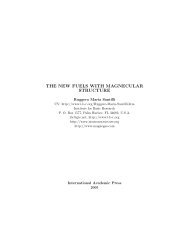Toroidal configuration of the orbit of the electron of the hydrogen ...
Toroidal configuration of the orbit of the electron of the hydrogen ...
Toroidal configuration of the orbit of the electron of the hydrogen ...
You also want an ePaper? Increase the reach of your titles
YUMPU automatically turns print PDFs into web optimized ePapers that Google loves.
1 IntroductionWeak external static uniform magnetic field B causes anomalous Zeemansplitting <strong>of</strong> <strong>the</strong> energy levels <strong>of</strong> <strong>the</strong> <strong>hydrogen</strong> atom, with ignorably smalleffect on <strong>the</strong> charge distribution <strong>of</strong> <strong>the</strong> <strong>electron</strong>. In <strong>the</strong> case <strong>of</strong> a more intensemagnetic field which is strong enough to cause decoupling <strong>of</strong> a spin-<strong>orbit</strong>alinteraction (in atoms), e¯hB/2mc > ∆E jj ′ ≃ 10 −3 eV, i.e. B ≃ 10 5 Gauss, anormal Zeeman effect is observed, again with ignorably small deformation <strong>of</strong><strong>the</strong> <strong>electron</strong> <strong>orbit</strong>s.In <strong>the</strong> case <strong>of</strong> weak external magnetic field B, one can ignore <strong>the</strong> quadraticterm in <strong>the</strong> field B because its contribution is small in comparison withthat <strong>of</strong> <strong>the</strong> o<strong>the</strong>r terms in Schrödinger equation so that <strong>the</strong> linear approximationin <strong>the</strong> field B can be used. In such a linear approximation, <strong>the</strong> wavefunction <strong>of</strong> <strong>electron</strong> remains unperturbed, with <strong>the</strong> only effect being <strong>the</strong> wellknown Zeeman splitting <strong>of</strong> <strong>the</strong> energy levels <strong>of</strong> <strong>the</strong> <strong>hydrogen</strong> atom. In bothZeeman effects, <strong>the</strong> energy <strong>of</strong> interaction <strong>of</strong> <strong>electron</strong> with <strong>the</strong> magnetic field isassumed to be much smaller than <strong>the</strong> binding energy <strong>of</strong> <strong>the</strong> <strong>hydrogen</strong> atom,e¯hB/2mc ≪ me 4 /2¯h 2 = 13.6 eV, i.e. <strong>the</strong> intensity <strong>of</strong> <strong>the</strong> magnetic field ismuch smaller than some characteristic value, B ≪ B 0 = 2.4 · 10 9 Gauss =240000 Tesla (1 Tesla = 10 4 Gauss). Thus, <strong>the</strong> action <strong>of</strong> a weak magneticfield can be treated as a small perturbation <strong>of</strong> <strong>the</strong> <strong>hydrogen</strong> atom.In <strong>the</strong> case <strong>of</strong> very strong magnetic field, B ≫ B 0 , <strong>the</strong> quadratic term in<strong>the</strong> field B makes a great contribution and can not be ignored. Calculationsshow that a considerable deformation <strong>of</strong> <strong>the</strong> <strong>electron</strong> charge distribution in<strong>the</strong> <strong>hydrogen</strong> atom occurs. Namely, under <strong>the</strong> influence <strong>of</strong> a very strongexternal magnetic field a magnetic confinement takes place, i.e. in <strong>the</strong> planeperpendicular to <strong>the</strong> direction <strong>of</strong> magnetic field <strong>the</strong> <strong>electron</strong> dynamics isdetermined mainly by <strong>the</strong> action <strong>of</strong> <strong>the</strong> magnetic field, while <strong>the</strong> Coulombinteraction <strong>of</strong> <strong>the</strong> <strong>electron</strong> with <strong>the</strong> nucleus can be viewed as a small perturbation.This adiabatic approximation allows one to separate variables inSchrödinger equation [1]. At <strong>the</strong> same time, in <strong>the</strong> direction along <strong>the</strong> direction<strong>of</strong> <strong>the</strong> magnetic field <strong>the</strong> motion <strong>of</strong> <strong>electron</strong> is governed both by <strong>the</strong>magnetic field effects and <strong>the</strong> Coulomb interaction <strong>of</strong> <strong>the</strong> <strong>electron</strong> with <strong>the</strong>nucleus.In this paper we briefly review some results on <strong>the</strong> <strong>hydrogen</strong> atom in verystrong external static uniform magnetic fields, focusing on <strong>the</strong> basic physicalpicture derived from <strong>the</strong> Schrödinger equation. Our consideration <strong>of</strong> <strong>the</strong>1














